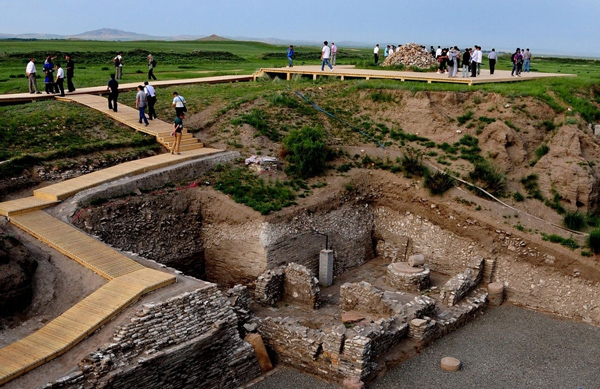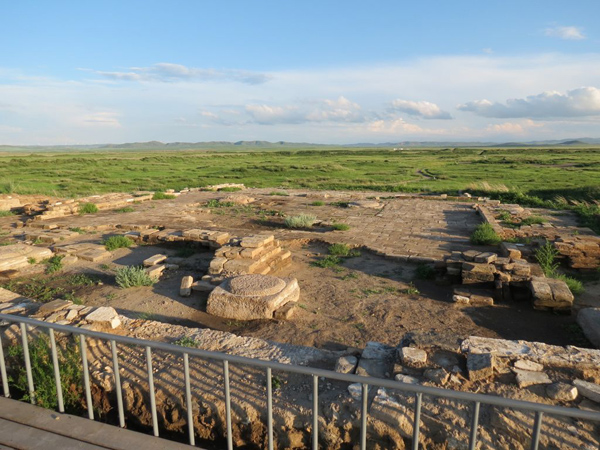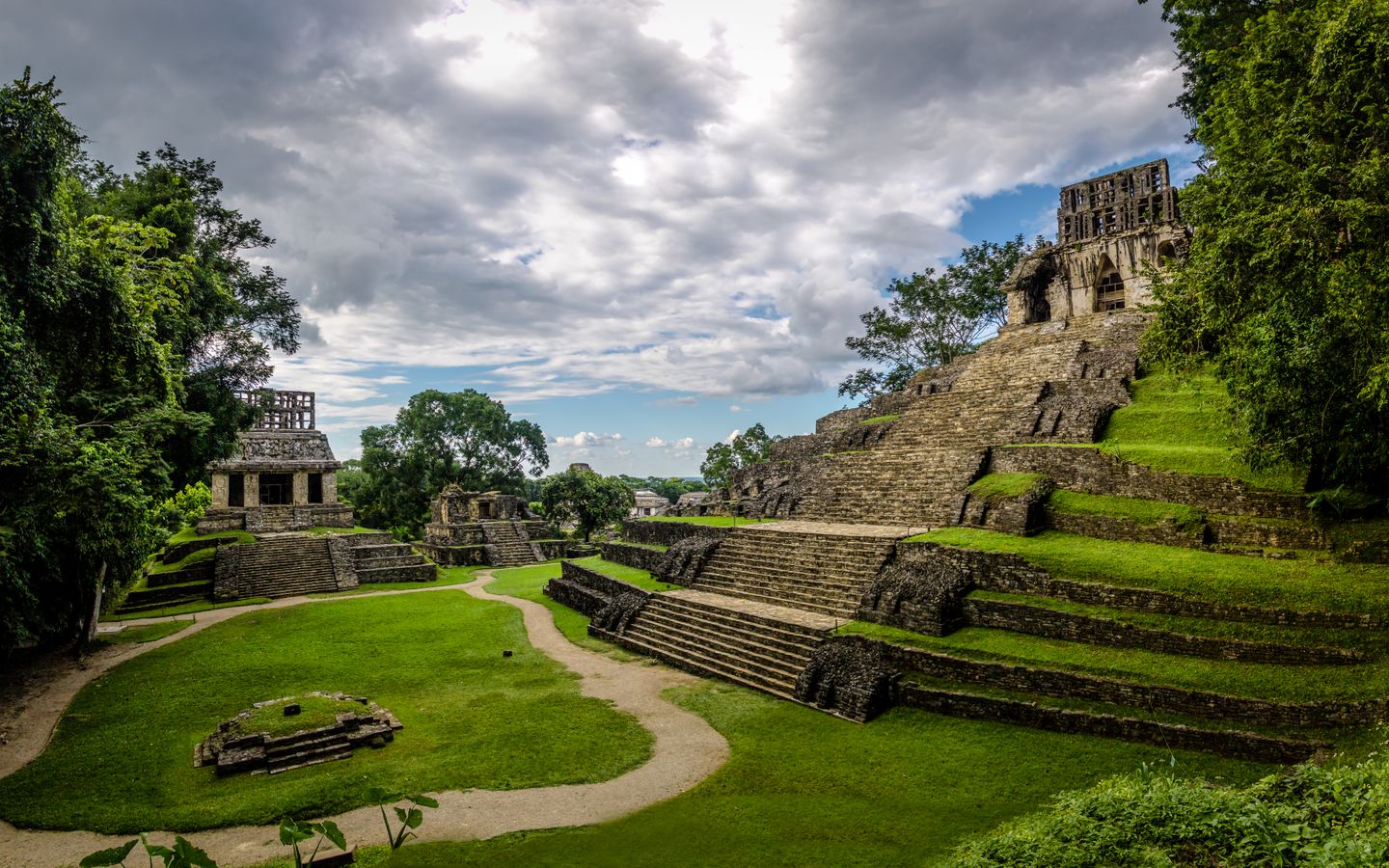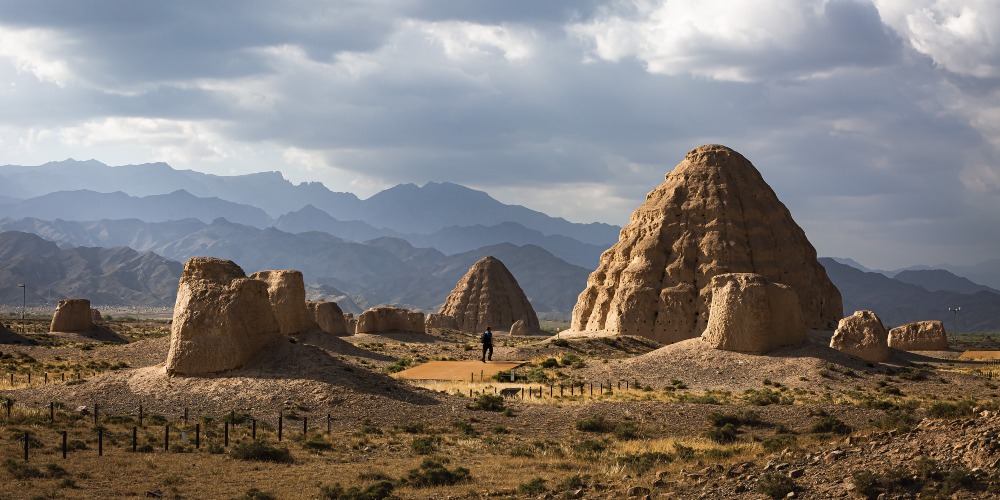Unveiling the Secrets of Yan Xiadu Ruins: A Must-Visit Historical Destination

An Essential Guide to Visiting Yan Xiadu Ruins
In This Guide
- An Essential Guide to Visiting Yan Xiadu Ruins
- The Rich History and Legends of Yan Xiadu Ruins
- Main Highlights: What You Absolutely Can’t Miss
- Planning Your Visit: A Practical Guide
- Tickets: Prices, Booking, and Tips
- How to Get There: A Complete Transportation Guide
- Local Cuisine and Accommodation Nearby
- Frequently Asked Questions
- Final Thoughts on Your Trip
The Yanshadu Ruins, a remarkable testament to China’s ancient Warring States period, beckon travelers with their rich tapestry of history and culture. Nestled in the picturesque Hebei Province, this archaeological site serves as a portal to a bygone era, where the legendary Yan State once flourished. As you stand amidst the remnants of this grand city, envision the bustling life that once thrived within its formidable walls.
A Journey Through Time
The Yan Xiadu Ruins are not just a collection of bricks and earth; they are the echoes of a civilization that played a pivotal role in shaping Chinese history. Established as the capital of the Yan State, this sprawling city reached its zenith under the reign of King Zhao in the mid Warring States period (475-221 BC). Here, political intrigue, cultural development, and economic prosperity intertwined, making it the largest city of its time.

Yan Xiadu Ruins.
What Awaits You
Visitors to the Yan Xiadu Ruins can immerse themselves in a landscape of ancient architecture and archaeological wonders. The city layout, with its grand palace structures, residential areas, and workshops, has been carefully preserved, providing a captivating glimpse into the urban planning and construction techniques of the era.
Highlights of Your Visit:
– Palatial Architecture: Marvel at the remnants of the main palace, Wuyangtai, with its impressive dimensions and sophisticated design that reflect the grandeur of the Yan court.
– Cultural Relics: Discover an array of artifacts unearthed during excavations, revealing the daily life and customs of the Yan people.
– Historic Legends: Learn about the famous stories associated with the site, including the poignant tale of Jing Ke, a hero whose legacy continues to resonate through Chinese literature and lore.

Yan Xiadu Ruins.
Nearby Attractions
Enhancing your visit to the Yan Xiadu Ruins, the surrounding area is dotted with other historical sites. The Golden Platform in Jintai Village, where poets and scholars congregated, and the Jing Ke Tower on Jingshan Mountain, are just a short distance away, offering further insights into the rich historical narrative of the Yan State.
As you embark on your exploration of the Yan Xiadu Ruins, prepare to be captivated not only by the remnants of a remarkable civilization but also by the stories of courage, innovation, and cultural richness that define this extraordinary chapter in Chinese history.
The Rich History and Legends of Yan Xiadu Ruins
Nestled between the winding banks of the Yishui River in Hebei Province, the Yan Xiadu Ruins (燕下都遗址) offer a captivating glimpse into a bygone era marked by power struggles and cultural flourishing. Once the capital of the Yan State during the tumultuous Warring States Period (475-221 BC), this ancient site bears witness to both the grandeur and eventual decline of one of China’s most significant states.

Yan Xiadu Ruins.
Historical Significance
The origins of Yan Xiadu trace back to the Western Zhou dynasty, when King Wu enfeoffed northern Yan to Shao, whose descendants would later establish a state. The capital, initially located at Ji (modern-day Beijing), was eventually moved to the banks of the Yishui River, where it flourished under the reign of King Zhao of Yan. His ambitious renovations transformed Xiadu into a vibrant metropolis, sprawling over 8 kilometers from east to west and 4 kilometers from north to south.
With its imposing rectangular walls, Yan Xiadu was the largest city of its time. The eastern section, where the remnants of palatial structures and workshops still stand, underscores the advanced urban planning and economic prosperity of the Warring States Period. Here, the main palace, Wuyangtai, exemplifies the architectural prowess of the era, built with tamped earth to a height of 11 meters. The layout reflects a society deeply invested in governance, trade, and culture, with districts designated for residential life, workshops, and even burial grounds for the nobility.

Yan Xiadu Ruins.
The city fell into decline following its conquest by the Qin state in 222 BC, leading to its eventual abandonment. However, the echoes of its past remain embedded in the landscape, waiting to be discovered by intrepid travelers.
Legends of Yan Xiadu
Beyond its historical framework, the legends surrounding Yan Xiadu add a rich layer of intrigue. One of the most poignant tales is that of Jing Ke, a heroic figure known for his audacious attempt to assassinate the first Emperor of China, Qin Shihuang. As the story goes, Prince Dan of Yan bid farewell to Jing Ke at the riverside of the Yishui River, an emotional moment filled with solemnity and resolve. The haunting lyrics of a song sung by Jing Ke, lamenting the cold winds and the uncertain fate of heroes, have been passed down through generations, capturing the hearts of many.
Moreover, the Golden Platform located in Jintai Village holds its own lore, believed to have been constructed by King Zhao to attract scholars and poets. It became a cultural nexus where intellectuals would gather, leaving behind a treasure trove of poetry that immortalizes the spirit of the Yan State.

Yan Xiadu Ruins.
Exploring the Ruins
Today, visitors to the Yan Xiadu Ruins can walk through the remnants of this ancient city, where the outlines of city walls and the foundations of palatial buildings still stand. The site is not only an archaeological treasure but also a testament to a civilization that valued culture, governance, and ambition. Nearby, the Jing Ke Tower on Jingshan Mountain honors the legendary figure with its majestic architecture, while various historic sites around the area enrich the narrative of Yan’s historical significance.
In conclusion, the Yan Xiadu Ruins are more than mere remnants of stone and earth; they are a tapestry of stories woven into the fabric of Chinese history. For travelers seeking to understand the depth of China’s past, a visit to this remarkable site is an enriching journey into the heart of ancient civilization, where history and legend beautifully intertwine.
Main Highlights: What You Absolutely Can’t Miss
Discover the Rich Heritage of Yan Xiadu Ruins
As you wander through the expansive grounds of the Yan Xiadu Ruins, you’re stepping into a chapter of Chinese history that dates back over 2,200 years. This ancient site, once the thriving capital of the Yan State during the Warring States Period, offers visitors a unique glimpse into the architectural and cultural achievements of early Chinese civilization. Here are the main highlights that you absolutely cannot miss during your visit:

Yan Xiadu Ruins.
1. The City Layout
The Yan Xiadu site covers an impressive area of 32 square kilometers, making it the largest city of its time. The city is divided into eastern and western sections, demarcated by a central wall. As you explore the well-preserved remnants, take note of the rectangular shape of the city, measuring 8 kilometers from east to west and 4 kilometers from north to south. This layout not only reflects the sophisticated urban planning of the Warring States Period but also serves as a testament to the advanced culture of the Yan State.
2. Palace Complex
At the heart of the eastern city lies the palace area, an architectural marvel comprised of three distinct construction groups. The main palace, Wuyangtai, stands as a magnificent two-storeyed structure built with tamped earth. Measuring 140 meters in length, 110 meters in width, and towering at 11 meters high, this building reflects the grandeur of the Yan State’s ruling elite. Marvel at the craftsmanship of the period as you envision the political and ceremonial activities that once took place here.

Yan Xiadu Ruins.
3. Cultural Relics and Artifacts
The site is rich in cultural relics, with many unearthed during excavations conducted since 1930. The eastern section of the city, particularly, has yielded a treasure trove of artifacts, including elaborately crafted pottery, beast-head pipelines, and tiles that showcase the artistic sophistication of the era. A visit to the burial grounds, where tombs of lords and nobility were arranged in orderly fashion, offers insights into the burial customs and social hierarchies of ancient China.
4. The Golden Platform
Just a short distance from the ruins, the Golden Platform in Jintai Village is steeped in legend. Built by King Zhao of the Yan State, it was said to attract talented scholars and poets. The platform is a poetic landmark where many literary figures have left their mark, making it a must-visit for those interested in Chinese literature and the arts.
5. Jing Ke and the Yishui River
The poignant tale of Jing Ke, a heroic figure who attempted to assassinate Qin Emperor Shihuang, is entwined with the history of Yan Xiadu. At the riverside of the Yishui River, where Jing Ke bid farewell, legends say he sang a solemn tune that resonates through time. This site offers a reflective spot to consider the larger-than-life narratives that shaped the region’s history.

Yan Xiadu Ruins.
6. Jingshan Mountain and Jing Ke Tower
For those who enjoy scenic views, a visit to Jingshan Mountain is rewarding. Ascend to the Jing Ke Tower, a striking 13-storeyed octagonal structure with a multi-eave roof. The tower not only offers panoramic views of the surrounding landscape but also connects visitors to the historical significance of the area, with nearby sites dedicated to Jing Ke, including the Jing Ke Hall and Cenotaph.
7. Engaging with History
As you explore the ruins and surrounding sites, consider joining a guided tour or engaging with local historians to deepen your understanding of the Yan State’s influence on Chinese history. Their insights can provide context to the ruins’ significance and the stories that have echoed through the ages.
Conclusion
A visit to the Yan Xiadu Ruins is not just a journey through ancient architecture and artifacts; it’s an immersive experience that connects you with the rich tapestry of Chinese history and culture. From the grandeur of the palace complex to the poignant tales of heroic figures, every corner of this site whispers stories waiting to be discovered. Don’t miss the chance to walk through history in this remarkable location!

Yan Xiadu Ruins.
Planning Your Visit: A Practical Guide
Discovering the Yan Xiadu Ruins: A Traveler’s Guide
Nestled in the picturesque landscape of Hebei Province, the Yan Xiadu Ruins offer a glimpse into China’s rich history during the Warring States Period. This ancient site provides an enchanting journey for international travelers interested in Chinese culture and history, inviting them to explore its remnants and the stories behind them.
Getting There
Location: The Yan Xiadu Ruins are located approximately 2.5 kilometers southeast of Yixian County, situated between the north and central Yishui River.

Yan Xiadu Ruins.
Transportation:
– By Car: The most convenient way to reach the ruins is by car. If you’re driving from Beijing, expect about a 2-hour journey.
– Public Transport: Buses from Yixian County can take you close to the site. Be sure to check local schedules for the latest information.
Opening Hours and Admission
- Hours: The site is generally open from 8:00 AM to 5:30 PM. However, it’s advisable to check in advance as hours may vary seasonally.
- Admission Fee: Entrance is usually free, but small fees may apply for guided tours or special exhibitions.

Yan Xiadu Ruins.
What to Expect
As you wander through the extensive ruins, you’ll discover:
- City Layout: The site spans approximately 32 square kilometers, with visible outlines of the city walls that mark the eastern and western sections of the ancient capital.
- Cultural Relics: Explore five distinct districts that showcase the city’s past, including:
- Palace Area: Featuring the impressive Wuyangtai, a two-story structure made from tamped earth, which served as the central palace.
- Workshops: Discover areas where artisans crafted goods, highlighting the city’s economic prowess.
- Residential Areas: Wander through remains of ancient homes that housed the citizens of this once-thriving metropolis.
-
Graveyards: Visit the carefully arranged tombs of nobility, where significant archaeological finds were made.
-
Surrounding Sites: Nearby attractions include the Golden Platform in Jintai Village and the historic sites around Jingshan Mountain, including the Jing Ke Tower, which commemorates the legendary figure Jing Ke.

Yan Xiadu Ruins.
Tips for Your Visit
- Guided Tours: Consider joining a guided tour to gain deeper insights into the historical significance of the ruins and archaeological finds.
- Footwear: Wear comfortable shoes, as the terrain can be uneven and you will likely want to explore extensively.
- Photography: Bring your camera! The ruins present numerous photo opportunities against the backdrop of Hebei’s natural beauty.
- Local Cuisine: After exploring, indulge in regional dishes at local eateries in Yixian County to complete your cultural experience.
Nearby Accommodations
While visiting Yan Xiadu, consider staying in Yixian County for convenient access to the site and other local attractions. Options range from budget hostels to comfortable hotels, providing a variety of experiences to suit different preferences.
Conclusion
A visit to the Yan Xiadu Ruins is not just a step back in time; it is an invitation to immerse yourself in the narratives that shaped ancient China. From the remnants of a bustling city to the tales of legendary heroes, this site promises to enrich your understanding of Chinese history and culture. Plan your visit, and prepare to be captivated by the echoes of the past.
Tickets: Prices, Booking, and Tips
When planning your visit to the Yan Xiadu Ruins (燕下都遗址), understanding ticket prices, booking options, and useful tips can enhance your experience and ensure a smooth journey through this fascinating piece of Chinese history.
Ticket Prices
- General Admission: The admission fee for the Yan Xiadu Ruins is approximately RMB 50 (about $7.50 USD). This fee grants you access to the archaeological site and its surrounding historical features.
- Discounts: Reduced tickets are often available for students, seniors, and groups. Always check for any current promotions or special rates that might apply during your visit.
Booking Options
- On-Site Purchase: Tickets can be purchased directly at the entrance to the site. It’s advisable to arrive early, especially during peak tourist seasons, to avoid long queues.
- Online Booking: While some travelers prefer the convenience of online booking, as of now, it’s recommended to check local travel agencies or platforms specialized in Chinese attractions, as online availability may vary.
- Tour Packages: Consider joining a guided tour that covers Yan Xiadu along with other historical sites in the Hebei Province. These packages often include transportation, a knowledgeable guide, and entrance fees.
Tips for Visiting
- Timing Your Visit: The best time to visit the Yan Xiadu Ruins is during the spring (April to June) and autumn (September to November) when the weather is pleasant and the landscape is particularly beautiful.
- Getting There: The ruins are located approximately 2.5 kilometers southeast of Yixian County. Public transportation options include buses and taxis from nearby cities. If driving, ample parking is available.
- What to Bring: Comfortable walking shoes are essential, as the site encompasses a large area with uneven terrain. Don’t forget your camera to capture the stunning ruins and surrounding scenery!
- Respect the Site: As a protected historical site, it’s crucial to follow guidelines to help preserve the integrity of Yan Xiadu. Avoid climbing on the structures and refrain from littering.
- Explore Nearby Attractions: Extend your visit by exploring nearby sites such as Jingshan Mountain and the Golden Platform in Jintai Village, which are rich in history and legend.
By planning ahead and following these guidelines, you’ll be well-prepared to immerse yourself in the rich history and culture of the Yan Xiadu Ruins, making your journey through ancient China a memorable one.
How to Get There: A Complete Transportation Guide
Navigating Your Way to the Yan Xiadu Ruins
The Yan Xiadu Ruins, a significant archaeological site that offers a glimpse into the grandeur of the ancient Yan State during the Warring States Period, is located in Hebei Province, approximately 2.5 kilometers southeast of Yixian County. Getting there may require a bit of planning, but the journey is well worth the effort for history enthusiasts eager to explore this fascinating remnant of China’s past.
By Air
The nearest major airport to Yan Xiadu is Beijing Capital International Airport (PEK), situated about 150 kilometers away. From the airport, you can choose from several transportation options:
-
Domestic Flights: If you’re coming from another city in China, you can fly directly to Shijiazhuang Zhengding International Airport (SJW), which is closer to Yixian County.
-
Direct Transfers: Arrange for a private car or shuttle service from either Beijing or Shijiazhuang. This is the most convenient option, especially for international travelers with luggage.
By Train
Traveling by train is a popular and efficient way to reach Yixian County:
-
High-Speed Rail: Take a high-speed train from Beijing West Railway Station to Shijiazhuang Railway Station. The journey typically takes about 1.5 to 2 hours.
-
Connecting to Yixian: From Shijiazhuang, transfer to a local train or bus heading to Yixian County. The train ride will take approximately 1.5 hours.
By Bus
For those who prefer bus travel:
-
Long-Distance Buses: Buses from Beijing to Yixian County depart from various bus stations, including the Liujiayao Long-Distance Bus Station. The journey can take anywhere from 3 to 4 hours, depending on traffic conditions.
-
Local Buses: Once in Yixian, local buses or taxis can take you the remaining distance to the Yan Xiadu Ruins.
Car Rentals
If you prefer the independence of driving:
- Renting a Car: Car rental services are available at both Beijing and Shijiazhuang airports. Follow the G4 Expressway for a scenic drive through Hebei Province. The drive from Beijing will take approximately 2 to 3 hours, depending on traffic.
Local Transportation in Yixian
Once you arrive in Yixian County, there are several options to reach the Yan Xiadu Ruins:
-
Taxi Services: Taxis are readily available and can take you directly to the ruins. Make sure to have your destination written in Chinese, as not all drivers may speak English.
-
Public Transportation: Local buses frequently travel to the Yan Xiadu area. Keep an eye out for signs indicating routes to historical sites.
Tips for Your Journey
-
Language Barrier: While traveling, it may be beneficial to have a translation app handy or a phrasebook for basic communication, especially in less touristy areas.
-
Timing Your Visit: The site is best visited during the spring or autumn months when the weather is mild. Aim to arrive early in the day to avoid crowds and to fully appreciate the site’s ambiance.
-
Cultural Sensitivity: As you explore this historical site, be respectful of its significance. Follow any local guidelines or rules to ensure the preservation of these ancient ruins.
With this comprehensive transportation guide, you are well-equipped to embark on your journey to the Yan Xiadu Ruins, where history and culture await your discovery. Enjoy your travels!
Local Cuisine and Accommodation Nearby
When you visit the Yan Xiadu Ruins, immerse yourself not only in the rich history but also in the delightful local flavors and comfortable accommodations that enhance your experience. Here’s a curated selection of some must-try dishes and recommended places to stay, ensuring your journey through this historical site is as fulfilling as it is enlightening.
Local Cuisine
1. Hebei Braised Noodles (河北炸酱面)
A staple of the region, these braised noodles are served with a rich sauce made from fried soybeans, minced pork, and fresh vegetables. The dish is hearty and flavorful, perfect for refueling after a day of exploring the ruins.
2. Yixian Sliced Meat (易县片儿肉)
This dish features thinly sliced pork, often stir-fried with seasonal vegetables, and is known for its tender texture and savory taste. It embodies the essence of local cooking, using fresh, regional ingredients.
3. Steamed Buns (包子)
No visit to China is complete without sampling these soft, fluffy buns filled with various ingredients, from meats to vegetables. The local variations often reflect the flavors of Hebei, making them a delightful snack as you wander the area.
4. Sweet Rice Balls (汤圆)
These glutinous rice balls are filled with sweet fillings like sesame or red bean paste and are often served in a warm syrup. They make a delicious dessert, providing a perfect ending to your culinary journey.
Accommodation Nearby
1. Yixian Hotel (易县宾馆)
Located just a short drive from the ruins, this hotel offers comfortable rooms and essential amenities. Its proximity to local attractions makes it a convenient base for your adventures.
2. Hebei Yixian International Hotel (河北易县国际大酒店)
This modern hotel combines comfort with elegance, featuring well-appointed rooms, dining options, and a fitness center. It’s an excellent choice for travelers seeking a bit more luxury while staying close to the historic sites.
3. Jingshan Mountain Guesthouse (京山山庄)
For a more rustic experience, consider staying at this guesthouse near Jingshan Mountain. It provides a cozy atmosphere and stunning views, making it ideal for those who appreciate nature alongside history.
4. Local Homestays
For a more immersive experience, consider booking a homestay with a local family. This option not only supports the community but also offers a unique opportunity to experience authentic Hebei hospitality and home-cooked meals.
Conclusion
As you explore the Yan Xiadu Ruins, let the local cuisine tantalize your taste buds and find comfort in one of the nearby accommodations. This blend of history, culture, and culinary delights will surely make your visit an unforgettable experience.
Frequently Asked Questions
Frequently Asked Questions about Yan Xiadu Ruins
1. Where are the Yan Xiadu Ruins located?
The Yan Xiadu Ruins are situated approximately 2.5 kilometers southeast of Yixian County in Hebei Province, China. They lie between the north and central Yishui River, making it a scenic site that is steeped in history.
2. What is the historical significance of Yan Xiadu?
Yan Xiadu was the capital of the Yan State during the mid Warring States Period (475-221 BC) and is considered the largest city of that era. It was known for its economic and cultural advancements, particularly under King Zhao of Yan, who renovated the city and contributed to its flourishing status.
3. What can I expect to see at the Yan Xiadu site?
Visitors to Yan Xiadu can explore the well-preserved ruins of the city, including outlines of the city walls and remnants of various districts such as the palace, workshops, residential areas, and burial grounds. The main palace, Wuyangtai, is a highlight, showcasing remarkable ancient architecture with its large tamped-earth construction.
4. Are there any guided tours available?
Yes, there are guided tours available for those interested in a more in-depth understanding of the history and significance of the site. Many tours include knowledgeable guides who can provide context and answer questions about the ruins and the surrounding areas.
5. What are some nearby attractions I should consider visiting?
In addition to the Yan Xiadu Ruins, consider visiting the Golden Platform in Jintai Village, a site rich in poetry and legend, or Jingshan Mountain, which houses the Jing Ke Tower and other historical landmarks related to the famous figure Jing Ke. These sites complement the historical narrative of Yan Xiadu.
6. How can I best prepare for my visit?
It’s advisable to wear comfortable walking shoes as you will be exploring a large archaeological site. Bring water, sun protection, and a camera to capture the stunning views and historical artifacts. If you’re interested in specific details, consider doing a bit of reading on the Warring States Period beforehand.
7. What is the best time of year to visit Yan Xiadu?
The best times to visit are during spring (April to June) and autumn (September to November) when the weather is mild and conducive to outdoor exploration. Avoid the peak summer months when temperatures can soar, making it less comfortable for walking tours.
8. Is there an entrance fee for the Yan Xiadu Ruins?
Yes, there is typically a small entrance fee to access the Yan Xiadu Ruins. It’s best to check in advance for the current fees and any additional charges for guided tours or special exhibitions that may be available during your visit.
Final Thoughts on Your Trip
As you prepare to depart from the captivating Yan Xiadu Ruins, take a moment to reflect on your journey through this ancient city—a site that has witnessed the rise and fall of dynasties, the flourishing of culture, and the indomitable spirit of its people.
Embracing the Legacy of Yan Xiadu
Walking through the remnants of Xiadu, you have not only traversed physical space but have also journeyed through time. The echoes of the Warring States Period resonate in the very earth beneath your feet, and the stories of its illustrious past come alive through the artifacts unearthed from its depths. From the impressive palace complex to the meticulously organized graveyards of nobility, every corner of this site invites you to delve deeper into the narratives of its inhabitants.
A Tapestry of Culture and History
As you reflect on your experiences, consider the rich tapestry of Chinese culture that envelops the site. The legends of Jing Ke, the Golden Platform, and the artistic relics you encountered speak to a civilization that valued intellect, artistry, and honor. This historical context adds layers to your understanding of not just Yan Xiadu, but of China as a whole—a country with a profound heritage that continues to shape its identity today.
Tips for Your Next Adventure
Before you leave, here are a few recommendations for making the most of your experience:
- Visit Nearby Historic Sites: Explore the Golden Platform and Jingshan Mountain to further enrich your understanding of the region’s history.
- Capture the Moment: Bring your camera to document the stunning landscapes and ancient architecture that define Yan Xiadu.
- Engage with Local Culture: Seek out local guides or participate in cultural workshops to deepen your appreciation for the traditions that have survived through centuries.
A Journey Worth Remembering
Your exploration of Yan Xiadu has undoubtedly left an indelible mark on your travel narrative. As you continue your journey through China, carry the spirit of this ancient capital with you, allowing its stories to inform your understanding of the present and inspire your future adventures. The ruins may be remnants of the past, but they remain a vibrant testament to the resilience and creativity of human civilization—an experience that will resonate long after your visit has concluded.